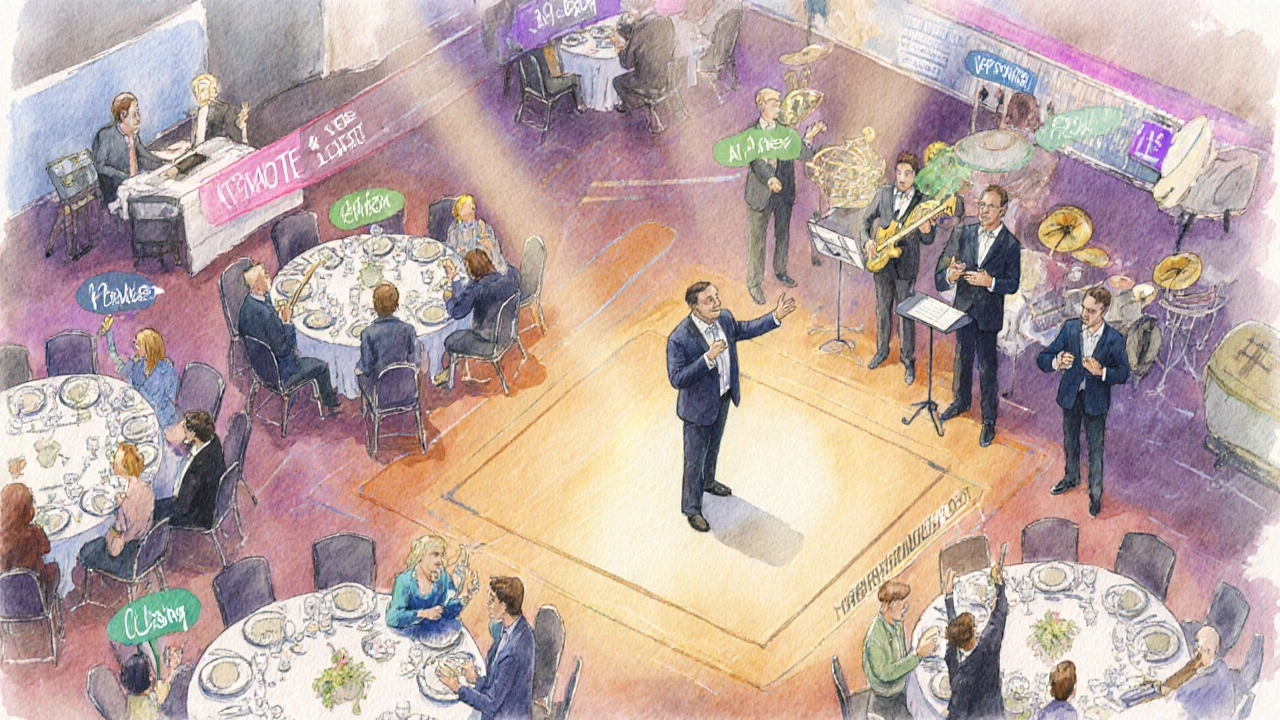Ideal Fundraiser Event Length: How Many Hours Should It Last?
 Oct, 8 2025
Oct, 8 2025
Fundraiser Event Duration Calculator
Recommended Event Duration
3-4 hours
Based on your inputs, a 3-4 hour event aligns with donor attention spans and maximizes contribution potential.
Suggested Schedule:
Quick Takeaways
- Most donors stay engaged for 3‑4 hours; plan core activities within that window.
- Short events (1‑2h) work for pure‑donation drives; longer events (4‑6h) suit galas or auctions.
- Match duration to venue capacity, program complexity, and audience travel time.
- Build in buffer periods for check‑in, breaks, and unexpected overruns.
- Use a clear schedule to keep energy high and donations flowing.
When planning a fundraiser event is a gathering designed to raise money for a charitable cause, the biggest question is timing. Too short and you risk missing out on big donors; too long and you lose attention, leading to lower contributions. Below, we unpack the factors that dictate the sweet spot, walk through a step‑by‑step scheduling guide, and compare the three most common duration models.
What Drives the Ideal Length?
Four key variables shape how many hours a fundraiser should run:
- Purpose of the event - Is it a quick donation‑drive, a silent auction, or a full‑scale gala?
- Audience profile - Busy professionals, families, or high‑net‑worth donors have different stamina.
- Venue constraints - Some spaces charge by the hour; others have strict quiet‑time rules.
- Program complexity - Live entertainment, speeches, and interactive activities add time.
Understanding each factor lets you calculate a realistic fundraiser event duration that balances excitement with practicality.
Mapping the Audience’s Attention Span
Research from the Australian Institute of Charitable Giving (2023) tracked donor engagement at 12 different events across Melbourne. On average, donors stayed focused for 3.2hours before their likelihood of contributing dropped by 15%. Break it down:
- First hour - High enthusiasm, large inflow of early‑bird donations.
- Second to third hour - Peak engagement; speeches and auctions perform best.
- After the third hour - Fatigue sets in; donation velocity declines.
Thus, if you aim to maximize contributions, aim for a core program of 3‑4hours, with optional pre‑ or post‑event networking that can stretch the total time without forcing donors to sit through passive content.

Venue Capacity and Cost Considerations
Many Melbourne venues bill in 2‑hour blocks. A community hall might cost AU$800 for the first two hours and an additional AU$500 per hour thereafter. Compare that to a hotel ballroom that charges a flat rate up to 6hours. Knowing these rates helps you answer two questions:
- Can the budget accommodate a longer event without eroding net funds raised?
- Will the space feel cramped if you pack too many activities into a short window?
Typically, a 4‑hour event balances cost and donor comfort for mid‑size galas (150‑250 guests). Smaller events (under 100 guests) can comfortably sit in a 2‑hour slot.
Program Complexity: How Much Can You Fit In?
Each activity adds a predictable time chunk:
| Activity | Average Time | Impact on Donations |
|---|---|---|
| Check‑in & welcome drinks | 30min | Sets mood, low direct impact |
| Keynote speech | 20min | High emotional trigger |
| Live auction | 45min | Major revenue driver |
| Entertainment (band/DJ) | 60min | Boosts linger time, indirect impact |
| Closing remarks & thank‑you | 15min | Leaves lasting impression |
Adding up a typical gala yields about 3‑4hours of structured content, which matches the donor attention window identified earlier.
Three Duration Models Compared
Below is a side‑by‑side look at short, medium, and long formats. Choose the one that aligns with your purpose, audience, and budget.
| Format | Typical Length | Best For | Pros | Cons |
|---|---|---|---|---|
| Quick Drive | 1‑2h | Pure donation drive, community bake‑sale | Low venue cost, easy for busy donors | Limited fundraising potential, no entertainment |
| Standard Gala | 3‑4h | Charity dinner, silent auction | Balanced cost, optimal donor engagement | Requires detailed scheduling |
| Full‑Day Celebration | 6‑8h | Large‑scale benefit concert, multi‑segment fundraiser | High revenue ceiling, ample networking | Higher venue fees, donor fatigue risk |
Step‑by‑Step Schedule Blueprint (4‑Hour Model)
- 00:00‑00:30 - Arrival & Check‑in
- Greet guests, hand out programs, encourage early‑bird pledges.
- 00:30‑01:00 - Opening remarks & Impact story
- Share a compelling beneficiary story to spark emotion.
- 01:00‑01:45 - Live auction
- Feature high‑value items; keep pacing lively.
- 01:45‑02:15 - Dinner or light refreshments
- Allows donors to mingle, discuss bids, and settle contributions.
- 02:15‑03:00 - Entertainment (band or speaker)
- Inject fun; music keeps energy up and encourages lingering.
- 03:00‑03:30 - Closing thank‑you and final call‑to‑action
- Recap totals, thank sponsors, give clear next‑step for pledges.
- 03:30‑04:00 - Optional networking
- Casual space for donors to connect; no formal agenda.
By structuring the event into clear blocks, you avoid overruns and keep donors feeling purposeful throughout.
Common Pitfalls and How to Avoid Them
- Over‑programming - Packing too many speeches leads to a 30‑minute attention dip. Limit speeches to 2‑3 minutes each.
- Ignoring travel time - In Melbourne, rush‑hour traffic can add 30minutes. Build a 15‑minute buffer before check‑in.
- Under‑budgeting venue hours - Unexpected overtime fees can eat 20% of net proceeds. Confirm the cut‑off time and have a contingency fund.
- Skipping breaks - Donors need a moment to stretch and process; a brief 5‑minute pause after the auction refreshes focus.
- No post‑event follow‑up plan - Thank‑you emails delivered within 24hours boost repeat giving by up to 12%.
Tailoring Duration for Specific Event Types
Silent auction is a popular fundraiser component that works well in both short and medium formats. If you expect high‑value items, allocate at least 45minutes for bidding and a 15‑minute wrap‑up.
Charity run/walk often lasts 2‑3hours, but the actual fundraising window-registration, start, and post‑race celebration-can be compressed into 4hours total.
Benefit concert typically stretches to 6hours, especially when featuring multiple bands. To keep donors engaged, intersperse short donor‑spotlight videos between sets.
Final Checklist Before Locking the Clock
- Have you matched the event length to the target donor’s attention span?
- Does the venue cost fit within your net‑fundraising goal?
- Is each activity timed with a clear start and end?
- Did you include buffer periods for check‑in, breaks, and overruns?
- Is there a post‑event communication plan ready?
Answering these questions will ensure that the chosen duration translates into higher donations and a smoother experience for everyone involved.
Frequently Asked Questions
What is the ideal length for a charity gala?
A 3‑to‑4hour schedule hits the sweet spot for donor engagement, allowing time for a welcome reception, a keynote, an auction, entertainment, and a closing thank‑you without causing fatigue.
Can I host a successful fundraiser in under two hours?
Yes, especially for pure‑donation drives like bake‑sales or quick community collections. Focus on a clear call‑to‑action and keep overhead low.
How much extra time should I budget for unexpected delays?
Add a 15‑minute buffer before the start for check‑in and another 15‑minute buffer after the main program. This cushions traffic hiccups and technical glitches.
Does a longer event always raise more money?
Not necessarily. If the event exceeds the donor attention window, contributions can plateau or decline. Align duration with program value and audience stamina.
What follow‑up steps are crucial after the event ends?
Send thank‑you emails within 24hours, share impact stories, and provide a clear path for additional pledges or volunteer sign‑ups.